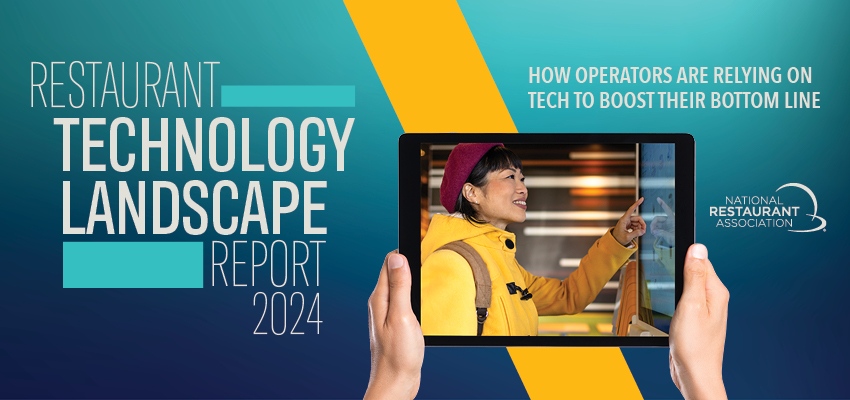Articles
April 09, 2024
Get with the program: Building loyalty grows business
Operators look to technology to enhance loyalty programs and increase sales.

Loyalty programs enhance the customer experience by allowing operators to provide more personalized service and incentivize repeat business.
Today, thanks to recent advances in technology, loyalty programs are highly regarded by restaurants and the guests who use them, National Restaurant Association research finds.
According to the Association’s new Restaurant Technology Landscape Report 2024, 96% of loyalty and reward program customers say they’re a good way to earn more “bang for their buck,” and 52% say they already participate in them at restaurants, coffee shops, snack places, or delis offering them.
Often used to capture consumer data, such as meal favorites and ordering preferences, loyalty programs enhance the customer experience by allowing operators to provide more personalized service and incentivize repeat business. Guests, particularly those looking for specials, discounts, or deals, are able to earn points toward menu freebies and swag, and other incentives during their visits and the programs provide the brand with a way to promote upcoming events and deals.
Most customers sign up for more than one restaurant loyalty program—3.6 on average. Leading the groups are Gen Z adults who belong to an average of 4.4 programs, while millennials participate in an average of 3.6, and Gen Xers, 3.9. Baby boomers report belonging to an average of 3.
It might be the lack of a physical card option that keeps them from engaging in the programs, says Hudson Riehle, the Association’s SVP of Research & Knowledge.
“Restaurants must carefully align their technologies with current and future customer bases,” he says. “While younger patrons may embrace a totally digital loyalty program, some of their older customers may prefer using the original physical card systems. Ensuring a hospitable restaurant experience in a higher-tech environment is extremely relevant for long-term success. It’s also the proverbial challenge for operators.”
When asked how they’d like to access loyalty programs, 60% of current users prefer using smartphone apps rather than carrying physical cards, 18% prefer a card and 22% don’t have a preference. Among prospective loyalty program members, 39% would rather use a card, and 33% would prefer using an app. Baby Boomers are less likely to commit to preferring a smartphone app, with 51% claiming they’d rather use a card, but they’re also most likely to say they don’t have a preference.
“It’s pretty rare now to find brands that don’t have a loyalty program, but if you don’t, it’s an effective and fast way to enhance marketing efforts, grow frequency, and build loyalists,” says Beth Hardy, marketing vice president for Modern Market Eatery. “It’s also an excellent tool to help you learn more about your guests’ purchasing habits, target potential new guests more effectively, and customize your marketing to fit their interests.”
Hardy adds that technology and the digital experience associated with it isn’t going away. She says it’s only going to grow and advance the way restaurant brands engage and interact with consumers.
“Technology is enabling brands to market to many more customers and more accurately track performance,” she says. “The metrics acquired help brands target their core customers even better, reduce waste, and potentially attract more loyal guests.”
According to the Association’s new Restaurant Technology Landscape Report 2024, 96% of loyalty and reward program customers say they’re a good way to earn more “bang for their buck,” and 52% say they already participate in them at restaurants, coffee shops, snack places, or delis offering them.
Often used to capture consumer data, such as meal favorites and ordering preferences, loyalty programs enhance the customer experience by allowing operators to provide more personalized service and incentivize repeat business. Guests, particularly those looking for specials, discounts, or deals, are able to earn points toward menu freebies and swag, and other incentives during their visits and the programs provide the brand with a way to promote upcoming events and deals.
Most customers sign up for more than one restaurant loyalty program—3.6 on average. Leading the groups are Gen Z adults who belong to an average of 4.4 programs, while millennials participate in an average of 3.6, and Gen Xers, 3.9. Baby boomers report belonging to an average of 3.
Align your technology with your specific customer base
Among consumers not currently enrolled in loyalty programs, 81% across all age groups say they’d participate in one if offered at a favorite restaurant. However, some prospective customers seem reticent to embrace the new technology involved.It might be the lack of a physical card option that keeps them from engaging in the programs, says Hudson Riehle, the Association’s SVP of Research & Knowledge.
“Restaurants must carefully align their technologies with current and future customer bases,” he says. “While younger patrons may embrace a totally digital loyalty program, some of their older customers may prefer using the original physical card systems. Ensuring a hospitable restaurant experience in a higher-tech environment is extremely relevant for long-term success. It’s also the proverbial challenge for operators.”
When asked how they’d like to access loyalty programs, 60% of current users prefer using smartphone apps rather than carrying physical cards, 18% prefer a card and 22% don’t have a preference. Among prospective loyalty program members, 39% would rather use a card, and 33% would prefer using an app. Baby Boomers are less likely to commit to preferring a smartphone app, with 51% claiming they’d rather use a card, but they’re also most likely to say they don’t have a preference.
More investment in loyalty programs ahead in 2024
Intent on building repeat business, 61% of limited-service operators and 52% of full-service operators say they plan to invest more in loyalty programs and rewards systems in 2024.“It’s pretty rare now to find brands that don’t have a loyalty program, but if you don’t, it’s an effective and fast way to enhance marketing efforts, grow frequency, and build loyalists,” says Beth Hardy, marketing vice president for Modern Market Eatery. “It’s also an excellent tool to help you learn more about your guests’ purchasing habits, target potential new guests more effectively, and customize your marketing to fit their interests.”
Hardy adds that technology and the digital experience associated with it isn’t going away. She says it’s only going to grow and advance the way restaurant brands engage and interact with consumers.
“Technology is enabling brands to market to many more customers and more accurately track performance,” she says. “The metrics acquired help brands target their core customers even better, reduce waste, and potentially attract more loyal guests.”
Get the report
Get the report
Sign up for our Newsletter
The latest news from the National Restaurant Association, published every other Thursday
By clicking Submit I agree to receive email communications from the National Restaurant Association and agree to our Privacy Policy(Opens in a new window).


